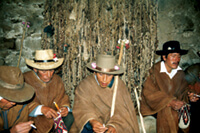Knotty Problem

Residents of San Cristobal de Rapaz, Peru, perform a New Year’s ritual in front of an enormous collection of khipus. Courtesy of Frank Salomon
Residents of San Cristobal de Rapaz, Peru, perform a New Year’s ritual in front of an enormous collection of khipus — those are the strands of knotted wool hanging in the background. Khipus are an ancient method of recording information, one that goes back to the Inca empire that pre-dated the arrival of Europeans. Though no one today knows how to interpret the meaning encoded in khipus, the objects are still used in religious ceremonies in remote communities such as Rapaz.
But the khipus of Rapaz were in danger of falling to pieces, victims of the elements, mold, and infestation — until, that is, UW anthropology professor Frank Salomon stepped in. He led a team of anthropologists to Rapaz with the intent of preserving both the khipus and the building in which they’re stored. Since the artifacts are still in use, Salomon knew he couldn’t remove them to the safety of a museum. For the Rapacitos, “the khipus are the documents of record of their past relationship with the sacred mountains,” Salomon says. “So we took the museum to the patrimony.” He rebuilt the khipu house and repaired the khipus, all while keeping them in place.
Published in the Winter 2010 issue



Comments
No comments posted yet.